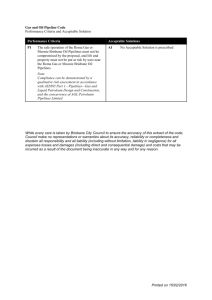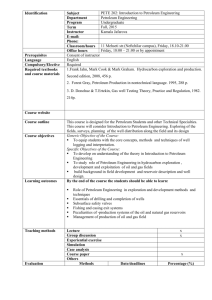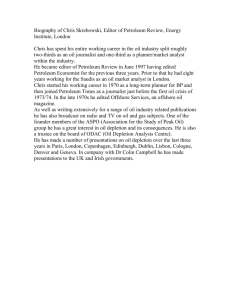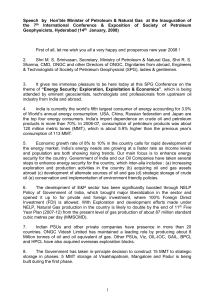IPPAI Conference on Gas
advertisement
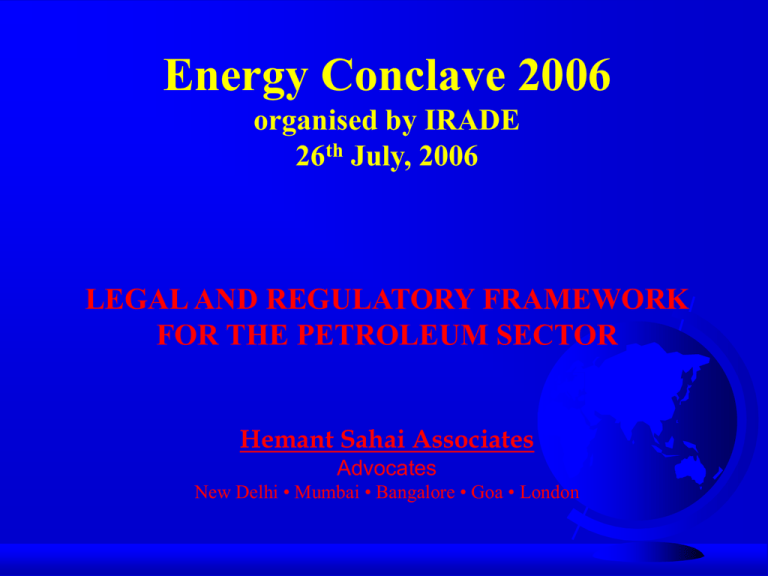
Energy Conclave 2006 organised by IRADE 26th July, 2006 LEGAL AND REGULATORY FRAMEWORK FOR THE PETROLEUM SECTOR Hemant Sahai Associates Advocates New Delhi • Mumbai • Bangalore • Goa • London CONSTITUTIONAL AND LEGAL FRAMEWORK • • • By virtue of Article 297 of the Constitution of India, petroleum in its natural state, including in the Territorial Waters and the Continental Shelf of India is vested in the Union of India; Petroleum Act, 1934 Petroleum Rules, 2002 • deal with the law relating to the import, transport, storage, production, refining and blending of petroleum. • • Oilfields (Regulation and Development) Act, 1948 Petroleum and Natural Gas Rules, 1959 • Provide for regulation of Petroleum Operations and grant of Licenses and Leases for exploration, development and production of Petroleum in India LEGAL FRAMEWORK • Petroleum and Minerals, Pipelines (Acquisition of Right of User in Land) Act, 1962 • Provides for acquisition of rights of way for laying pipelines • Territorial Waters, Continental Shelf, Exclusive Economic Zone and other Maritime Zones Act, 1976 • provides for the grant of a license by the Government to explore and exploit the resources of the continental shelf and exclusive economic zone and provide for the grant of License and Lease in respect of any land or mineral underlying the ocean, within the territorial waters, the continental shelf and exclusive economic zone of India by the Central Government LEGAL FRAMEWORK • Essential Commodities Act, 1955 • Price control • Petroleum and Natural Gas Regulatory Board Act, 2006 (yet to be brought into force) • Provides for the establishment of a Regulator for the Sector REGULATORY FRAMEWORK • Currently, the Government of India through the Ministry of Petroleum and Natural Gas (MOPNG) and Director General of Hydrocarbons regulates the Hydrocarbon sector; • The Petroleum and Natural Gas Regulatory Board Act, 2006 has been passed - yet to be brought into force; • The Act provides for the establishment of the Petroleum and Natural Gas Regulatory Board to regulate the refining, processing, storage, transportation, distribution, marketing and sale of petroleum, petroleum products and natural gas; • The Act does not deal with E&P, i.e. the production of crude oil and natural gas REGULATORY FRAMEWORK Key functions of the Regulator include : • ensuring uninterrupted and adequate supply of petroleum, petroleum products and natural gas in all parts of the country • to promote competitive markets • Protect consumer interest and foster fair trade and competition • Register entities to market notified petroleum products and natural gas; to establish and operate LNG terminals and to establish storage facilities for petroleum, petroleum products and natural gas REGULATORY FRAMEWORK Key functions of the Regulator…. Contd. • Authorise entities to lay, build, operate or expand a common carrier or contract carrier or local natural gas distribution network • Declare pipelines as common carrier or contract carrier • Notify Regulations for access to common/contract carrier and specify pipeline access code; for transportation rates; for access to city/local natural gas distribution network to ensure fair trade & competition and for technical and safety specifications REGULATORY FRAMEWORK Status of the Regulator under the Act • The Act prescribes an independent status for the Regulator – quasi judicial body; • The Central Government will have powers to lay down the broad policy framework, besides being entitled to intervene in matters adversely affecting public interest. EXPLORATION AND PRODUCTION • Private participation in gas exploration and production is pursuant to the NELP and in terms of the Oilfields (Regulation and Development) Act, 1948 and Petroleum and Natural Gas Rules, 1959 • Production Sharing model. • Gas can be freely marketed and sold by the constituents of PSC – crude has to be sold only to persons designated by Government of India • in NELP VIth round Freedom has been given to the contractor for marketing of oil and gas in the domestic market. EXPLORATION AND PRODUCTION NELP VI – PRINCIPAL FEATURES Upto 100% participation by foreign companies. No signature, discovery or production bonus. No mandatory state participation. No carried interest by National Oil Companies (NOCs). Income Tax Holiday for seven years from start of commercial production. Sharing of profit petroleum based on pre-tax investment multiple achieved by the contractor and is biddable. EXPLORATION AND PRODUCTION NELP VI – PRINCIPAL FEATURES Royalty for onland areas payable at the rate of 12.5% for crude oil and 10% for natural gas. For offshore areas, royalty payable at the rate of 10% for oil and natural gas. Royalty for discoveries in deep water areas beyond 400 m iso-bath payable at half the applicable rate for offshore areas for the first seven years of commercial production. Fiscal stability provision in the contract. Freedom to the contractor for marketing of oil and gas in the domestic market. To facilitate investors, a Petroleum Tax Guide (PTG) in place. PIPELINE TRANSPORTATION & STORAGE • The major gas sector infrastructure has been developed by GAIL including the major Hazira-Vijaipur-Jagdishpur (“HVJ”) pipeline. • Other players are OIL, Assam Gas Company, Gujarat Gas Company, Gujarat State Petroleum Corporation, Mahanagar Gas Limited and Indraprastha Gas Limited. • Right-of-way for laying pipelines is granted under the Pipelines Act – Notification by Government of India, additional clearances from highways, canals and other bodies. • The Petroleum Regulatory Board Act provides a framework for authorizations to lay, build, operate or expand pipeline and establish and operate LNG terminals. DISTRIBUTION • Today, GAIL is the primary gas transmission, distribution and marketing company in India accounting for almost 95 percent of the market share. • No specific rules that govern operation of distribution networks. Same Government authorizations and clearances mentioned for exploration and production are required – The Regulator will be required to establish such rules and protocols. • As regards tariff, no system in place to govern prices of distribution services in India, For use of GAIL pipelines, GAIL charges a flat rate to its customers, and revises such tariff based on approval from the Central Government – Once again The Regulator will be required to establish such rules and protocols for tariff determination and open access rules. DISTRIBUTION Guidelines for Laying Petroleum Product Pipelines was notified on 20th November 2002 and supplemented on 26th October 2004, to deregulate the oil sector and to attract investment in the petroleum product pipelines. The main features of the Guidelines are : – Categorization of pipelines into those of specified length (upto 300 km or more) originating from refineries, captive pipelines and those originating from ports; – Right of user (RoU) in land for laying pipelines under the Petroleum Pipelines (Acquisition of Right of User in Land) Act 1962 for the pipelines less than 300 km in length, will be granted in favour of applicant company treating such pipelines as captive pipelines; – For pipes more than 300 km in length, specified procedure shall be followed including a mandatory invitation of expression of interest from any company interested in taking capacity on a ‘take or pay’ basis; DISTRIBUTION Features …..Contd. – Common carrier principle shall be followed in case of excess capacity, on the basis of a tariff as approved by the competent authority; – The ROU acquisition under the Petroleum Pipelines (Acquisition of Right of User in Land) Act, 1962 will be subject to such conditions as may be deemed fit by the Government in public interest and subject to specified conditions – The guidelines are to remain in force till the Petroleum Regulatory Board is constituted. – After Petroleum Regulatory Board is constituted, the RoU in land for laying petroleum product pipelines will be granted by the Ministry of Petroleum & Natural Gas subject to fulfillment of requirements under the petroleum regulatory law. – Eligibility of parties seeking capacity will not be limited on the grounds that the party seeking capacity is neither a refinery nor possesses any marketing rights. IMPLICATION OF SUPREME COURT DECISION ON GUJARAT GAS ACT • The Government of Gujarat tried to introduce provisions pertaining to distribution networks in the State of Gujarat through the Gujarat Gas (Regulation of Transmission, Supply and Distribution) Act, 2001. • The Central Government took the view that it alone had powers to legislate on natural gas and LNG. • President of India referred the matter to the Supreme Court of India to provide its opinion on whether the State Governments or the Central Government had such powers under the Constitution of India. • On 25 March 2004, the Supreme Court of India has opined that natural gas in any physical form including LNG is a central subject and the State Governments have no power to legislate on it. FOREIGN INVESTMENT REGIME E&P and transportation • FDI upto 100% is permitted on the automatic route in oil (Other than refining) exploration in both small and medium size fields subject to and under the policy of Government on private participation in : (a) exploration of oil and (b) the discovered fields of National Oil companies • FDI upto 100% is permitted on the automatic route on petroleum product marketing, subject to the existing sectoral policy and regulatory framework in the oil marketing sector. • Investment of Rs 2,000 crores in the petroleum sector, over a 10 year period.) • FOREIGN INVESTMENT REGIME FDI upto 100% is permitted on the automatic route for petroleum product pipeline subject to and under the Government policy and regulations thereof. • FDI upto 100% is permitted for natural gas/LNG pipelines with prior Government approval. • 100% wholly owned subsidiary (WOS) is permitted for the purpose of market study and formulation under FIPB route. • 100% wholly owned subsidiary (WOS) is permitted for investment/financing. FOREIGN INVESTMENT REGIME Refining • FDI is permitted up to 26% in case of public sector units (PSUs). • PSUs will hold 26% and balance 48% by public. Automatic route is not available • In case of private Indian companies, FDI is permitted upto 100% under automatic route THANK YOU

